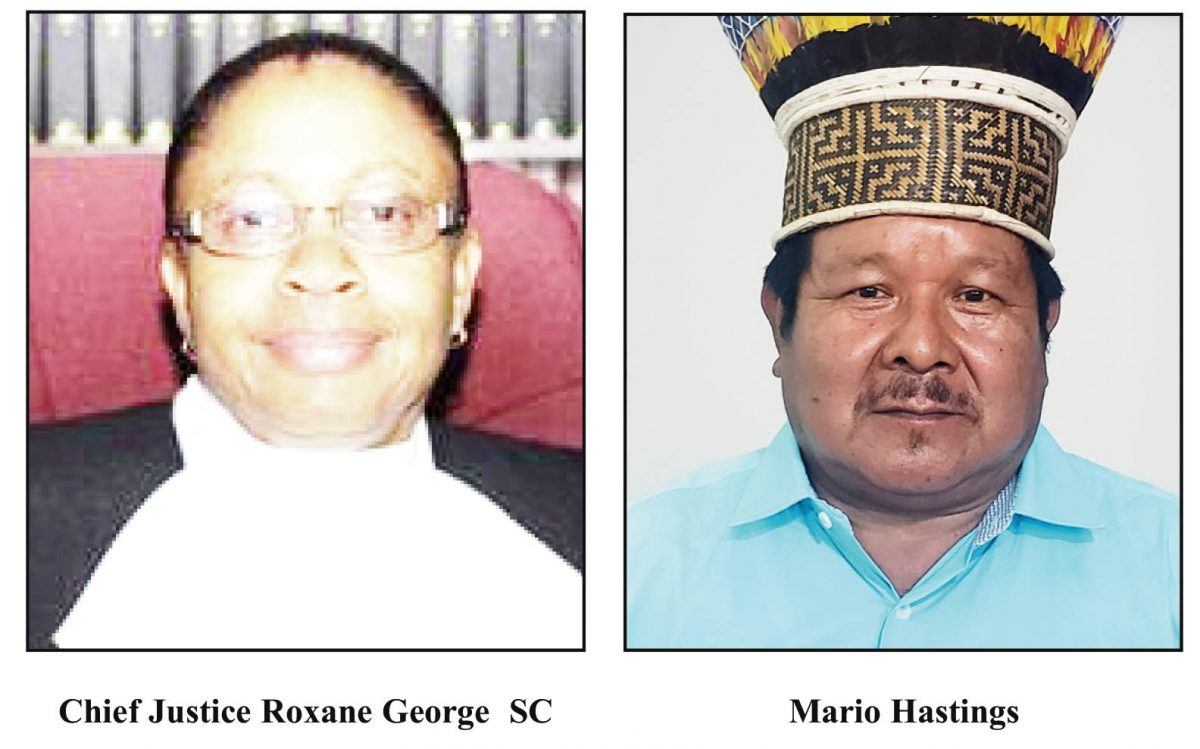In what will be seen as a historic decision, the Chief Justice has confirmed the rights of Indigenous peoples of the Upper Mazaruni to their ancestral lands, though she stopped short of saying that those rights are “to the exclusion of all others.”
This was the ruling delivered yesterday by acting Chief Justice Roxane George SC, in the decades-old litigation which had been filed against the Government of Guyana by the Indigenous peoples of the Upper Mazaruni.
Among other things, they sought legal recognition of their rights to traditional and ancestral lands.
For 24 years, communities that fall under the Upper Mazaruni District Council (UMDC) have been engaged in a legal battle to recognize their land rights.
Delivering her marathon ruling yesterday afternoon, Chief Justice George said that the Akawaio’s and Arekuna—the two Amerindian tribes at the centre of the litigation—do have rights to the land in question.
Referencing a plethora of case law precedent and legislation, and having regard to the evidence presented on behalf of the plaintiffs, the Chief Justice said that the two tribes have been able to prove that they have—from time immemorial—continuously occupied and held communal/aboriginal title and rights to the lands.
She made it clear, however, that those rights are subject to State lands/title and, therefore, could not be regarded as being to the exclusion of all others.
In fact, the Judge pointed out that while historically the lands may have only been occupied by the tribes, it is not so today. On this point she was keen in noting that at the time witnesses testified during the trial, there were other people occupying those lands.
She said, too, that while the Plaintiffs do have inalienable right to their ancestral lands, aboriginal title/property could be alienated to the State, though for the payment of compensation.
In the circumstances, Justice George said that she could not grant the relief sought by the Plaintiffs—to order that their right is to the exclusion of all others.
She also did not grant the declaration that the Indigenous peoples were seeking that they were being made subject to differential treatment on the basis of race, or were otherwise being discriminated.
The Judge said that not only was no evidence led to so substantiate the claim but she was keen in pointing out that unlike any other race, it is Indigenous peoples who alone have constitutional protection to ancestral lands.
Also not granted to the plaintiffs was an order for compensation.
In assessing this issue, Chief Justice George said that though it was their argument, the Plaintiffs led no evidence to support their contention of having been displaced, or otherwise dispossessed of their occupation.
She said that in fact, there were witnesses for the Plaintiffs who confirmed in their testimonies that they continued to live and use the lands as they did for fishing, farming and all other traditional purposes.
On those grounds, their request for compensation failed.
The matter had been brought against the State with the Attorney General listed as defendant. He was represented by Solicitor General Nigel Hawke and Kamal Ramkarran.
Meanwhile, the Plaintiffs legal team was led by attorney Nigel Hughes, together with Jed Vasconcellos and Ronald Daniels.
With the case pending before her for some years, the Chief Justice at the beginning of the proceedings yesterday extended her apologies to both sides and stated that the delay was due to pressing duties.
Background
Chairman of the UMDC and Toshao of Kato Mario Hastings had previously lamented to Stabroek News, the slow progression of the matter sine final arguments were heard back in 2017. They were told that the delay is due to a backlog of cases in the court.
Indigenous People’s activist and native of Phillipai Village Laura George had stressed that their fight for recognition was based on the fact that they wanted it to be determined that they are the real owners of lands, for which mining permits are being given.
The leaders had expressed their belief that after the two decades and a half that have elapsed, the matter should have already been put to rest rather than being dragged out.
Deputy Chairman of the UMDC and Toshao of Kamarang Lemuel Thomas had said that the land rights was one of the burning issues they were tasked with resolving and that their villagers were pressing for results.
The UMDC leaders had said that more harm was being inflicted on their communities through both renewals and issuance of new mining concession permits.
Hasting had said in the Upper Mazaruni they received separate land titles in 1991 but the lands that were given have little to no cultural meaning and large swathes of their traditional land were kept as state property.
According to Hastings, this was what led people living in the area to take the case to court seeking a judicial declaration confirming their rights to the land.
He noted that although international human rights bodies, such as the United Nations Committee on the Elimination of Racial Discrimination, have called upon Guyana to legally recognise the lands, territories and resources that indigenous peoples have traditionally owned or occupied, this was not done.
He had argued that that the decades-long denial of their land rights violated their constitutional rights as per the constitution of Guyana.

